◄ Carnets Geol. 16 (19) ►
Contents
[Introduction]
[Geology]
[Lithofacies]
[Tuff Beds]
[Biochronology]
[Discussion]
[Conclusions]
[Bibliographic references] and ... [Appendix]
Department of Geological Sciences, University of
Oregon, Eugene, Oregon (USA)
Published online in final form (pdf) on September 12, 2016
[Editor:
Bruno Granier]
• This paper gives
detailed stratigraphic documentation for the Aalenian-Bajocian ammonoid zonation
described in Taylor (1988).
• The ammonoid zonation provides a standard of
reference for late Aalenian and early Bajocian interval in the North
American Western
Cordillera.
• The zonation is constructed as a discrete biochronologic
scale.
• Tuff and other marker beds in the closely spaced stratigraphic
sections are important as they offer refinement of the local ammonoid
succession.
• The eight lithofacies described in this report document
the transgression of the Snowshoe Formation over an irregular topography and to
progressively higher terrain toward the west.
• This paper maintains a
shallower water depositional setting for at least the lower Warm Springs Member
than Blome & Nestell (1991) suggested for the member.
This paper documents the stratigraphic information upon which an ammonoid zonation from the lower part of the Snowshoe Formation in the Suplee area was originally established (Taylor, 1988). Ammonoid ranges from 22 measured stratigraphic sections reveal about 60 ammonoid species distributed among eight zones encompassing the late Aalenian and part of the early Bajocian stages. The sediments are dominantly volcaniclastic and, as a result, there are numerous tuff beds in the succession. As noted in Taylor (1982) the principal tuff beds (herein designated as units A through F) can be used jointly with the ammonite sequence to give precise correlations from section to section. Utilizing the ammonoids, tuff beds, and facies in combination gives a graphic representation of the westward transgression of the Snowshoe Formation as it enveloped an irregular topography, and lapped onto the topographically high Grindstone High to the west. The ammonoid zonation is significant in that it gives a standard of reference for the biochronology of the late Aalenian and early Bajocian ammonoids in the North American Western Cordillera.
• Jurassic;
• Aalenian;
• Bajocian;
• ammonite;
• biochronology;
• Snowshoe Formation;
• Oregon.
Taylor D.G. (2016).- The Weberg and Warm Spring Members of the Snowshoe Formation in Suplee area, Oregon: Lithofacies and Aalenian-early Bajocian ammonoid zonation.- Carnets Geol., Madrid, vol. 16, no. 19, p. 449-490.
Les membres Weberg et Warm Spring de la Formation de Snowshoe dans la région de Suplee, Orégon : Lithofaciès et zonation par ammonoïdés de l'intervalle Aalénien-Bajocien inférieur.- Cette publication présente l'ensemble des données stratigraphiques sur lesquelles a été établie la première zonation des ammonoïdés pour la partie inférieure de la Formation de Snowshoe dans la région de Suplee (Taylor, 1988). Les distributions des ammonoïdés à partir de 22 coupes stratigraphiques mettent en évidence une soixantaine d'espèces réparties en huit zones couvrant l'Aalénien supérieur et une partie du Bajocien inférieur. Les sédiments sont essentiellement volcanoclastiques et, de ce fait, on reconnaît de nombreuses couches de tuf dans la succession stratigraphique. Comme cela a été indiqué dans Taylor (1982), les principales couches de tuf (appelées ici unités A à F) peuvent être utilisées conjointement avec les ammonitofaunes successives pour établir des corrélations précises de coupe à coupe. L'utilisation conjointe des ammonoïdés, des couches de tuf et des faciès donne une représentation graphique de la transgression de la Formation de Snowshoe en direction de l'ouest, drapant une topographie irrégulière et se terminant par un biseau occidental contre le paléorelief du Grindstone High. Cette zonation par les ammonoïdés est fondamentale car elle fournit une norme de référence pour la biochronologie des ammonoïdés de l'Aalénien supérieur et du Bajocien inférieur de la Cordillère nord-américaine occidentale.
• Jurassique ;
• Aalénien ;
• Bajocien ;
• ammonite ;
• biochronologie ;
• Formation de Snowshoe ;
• Orégon.
Marine sedimentation in continental margins can
result in formations having quite rapid facies changes. This is the case for the Snowshoe Formation in the Suplee area of eastern
Oregon (Fig. 1 ![]() ), where the unit transgressed over an uneven terrain, and where
there were sediment contributions predominantly from the erosion of volcanics
and basement rocks (Dickinson & Vigrass,
1965; Dickinson
& Thayer, 1978). There
can be wholesale facies transitions within the short distance of 10 km. These swift changes may pose challenges when attempting to establish a
biochronology. Such was the case
when Imlay (1973) produced a classical and important study of the
ammonoid fauna from the Snowshoe Formation. His information came from a large suite of localities, many of which were
provided by geologists who worked in the area over the years, but he did not
have close stratigraphic and superpositional control at his disposal. As a
result, the faunal succession he developed was a preliminary effort.
), where the unit transgressed over an uneven terrain, and where
there were sediment contributions predominantly from the erosion of volcanics
and basement rocks (Dickinson & Vigrass,
1965; Dickinson
& Thayer, 1978). There
can be wholesale facies transitions within the short distance of 10 km. These swift changes may pose challenges when attempting to establish a
biochronology. Such was the case
when Imlay (1973) produced a classical and important study of the
ammonoid fauna from the Snowshoe Formation. His information came from a large suite of localities, many of which were
provided by geologists who worked in the area over the years, but he did not
have close stratigraphic and superpositional control at his disposal. As a
result, the faunal succession he developed was a preliminary effort.
Follow-up work by Taylor (1988) then attempted to take Imlay's (1973) accomplishments to the next step by refining the ammonoid succession. To do this several stratigraphic sections were measured, some of which were spaced merely hundreds of meters from one another, to establish superpositional control for the ammonoids, while at the same time documenting the lithofacies changes. This work tests a methodology of employing closely spaced stratigraphic sections and using local tuff beds to assist correlation in an effort to develop an ammonoid zonation in a depositionally complex setting.
Figure 1: Map giving distribution of the Snowshoe Formation (shaded) in the Suplee area and locations of stratigraphic sections. Izee is 32 km miles east of Suplee. "Star" denotes type locality for Euhoploceras crescenticostatum and Docidoceras schnabelei (Taylor, 1988), both from about 38 m above base of Weberg Member. Numbers for section locations do not correspond to those in Taylor (1988). The type sections for zones and new species described in Taylor (1988) are given in this report with reference to the numbering sequence in this figure. |
The southwestern part of the Blue Mountains Province of eastern Oregon preserves a thick sequence of early Mesozoic rocks in what has come to be known as the Suplee-Izee area. The Mesozoic there was first studied by Packard (1928), while Lupher (1941) furnished the first detailed description of the geology, including the Snowshoe Formation, upon which this work is based. This paper focuses on the formation in the western part of its exposure area, the Suplee area. While the Snowshoe was first described by Lupher (1941), refinements by Dickinson & Vigrass (1965) and Smith (1980) have brought us to our present understanding of the formation and its members in the Suplee-Izee area. The formation is a predominantly volcaniclastic sequence about 1,000 m thick and has been incipiently metamorphosed to the prehnite-pumpellyite zone (Dickinson & Thayer, 1978). It was deposited in a basinal setting in the Izee area (= Izee Basin of Smith, 1980), while the sediments to the west in the Suplee Area were deposited on the Suplee Platform (Smith, 1980).
The formation in the Suplee area consists of three members, the Weberg, Warm Springs, and Basey, in ascending stratigraphic order. The study focuses on the former two members. The Weberg is a calcareous sandstone and siltstone unit ranging up to about 50 m thick while the superjacent Warm Springs Member is a laminated mudstone that may be more than 300 m thick. There are olive-gray mudstones that Dickinson and Vigrass (1965) allocated to the Basey Member. These occur above the "typical" Warm Springs brown-gray mudstones and they (Dickinson & Vigrass, op. cit.) noted that it is often difficult to distinguish the two. The olive-gray beds commonly are superjacent to andesitic flows and the green coloration is reflective of the abundant chlorite, a diagenetic product of the fresh, or little reworked, volcanic detritus that had been introduced during deposition. In this report the olive-gray mudstone lithology is allocated to the Warm Springs Member, as it is texturally similar to the brown-gray beds. The superjacent Basey Member, then, is restricted to sandstones and interbedded siltstones deposited within a volcaniclastic fan apron.
The Snowshoe Formation within the Suplee Platform transgressed westward over a basement composed of Early Jurassic, Triassic, and Paleozoic rocks. The Snowshoe overlapped generally younger rocks in the east to progressively older rocks to the west. See Dickinson & Vigrass (1965) for a description of these units. In the eastern part of the Suplee area the Snowshoe overlaps the Pliensbachian to Toarcian Mowich Group, and the two formations encountered in the studied stratigraphic sections are the Robertson (conglomerate) and Hyde (volcanic sandstone). Farther to the west the Snowshoe overlaps the two members of the Carnian Vester Formation; these include mudstones of the Brisbois Member and the conglomerates of the Begg Member. The Grindstone mélange (Buddenhagen, 1967; Dickinson & Vigrass, 1965; Dickinson & Thayer, 1978; Blome et al., 1986; Blome & Nestell, 1991) composed of varied Devonian to Triassic lithologies occurs west of the Camp Creek Fault, a thrust fault that elevated the western part of the Suplee area prior to deposition of the Snowshoe deposition.
By the early 1980's (Coney et al., 1980; Coney, 1981) it became apparent that the western margin of North America, including Oregon, is composed of a collage of more than 50 exotic terranes, many of which had been displaced significant distances prior to their accretion to the continent. The Snowshoe Formation is associated with the "Izee Terrane", which occurs in the southern part of the Blue Mountains Province. Tectonic settings for the Snowshoe Formation have been proposed among others by Dickinson & Thayer (1978) and Dickinson (1979). A current proposal is that the formation is part of a large successor or collisional basin (Dorsey & Lamaskin, 2007; Lamaskin et al., 2009, 2011), with a suggested accretion to the North America craton prior to Late Jurassic time (Lamaskin et al., 2015).
Taylor et al. (1984) discussed Jurassic ammonoid provincialism, tectonostratigraphic terranes, and the inferred relative displacement of terranes with respect to one another and the craton. The ammonoid record is poor on the craton for the interval described herein (Imlay, 1980; Taylor et al., 1984), while the record is better for certain of the exotic terranes (Poulton et al., 1992). The Snowshoe Formation yields a mixture of Tethyan, pandemic and Athabascan genera. The latter indicate a location in the northeast Pacific region, which is consistent with the proposal of Lamaskin et al. (2015) of accretion of terranes from the Blue Mountains region by the end of the Middle Jurassic.
Eight lithofacies are described below from the
Weberg and Warm Springs members. Two
transects of stratigraphic sections termed the southern and northern transects
respectively reflect the distribution of these facies (Figs. 2 ![]() - 3
- 3 ![]() ; Appendix). The following descriptions are based on hand sample and thin-section
study, and several samples from calcite-rich sandy lithologies which were
digested in acid. Quantitative
measures were derived from sieve analysis of siliciclastic residue and examining
roundness and sphericity of chert grains.
; Appendix). The following descriptions are based on hand sample and thin-section
study, and several samples from calcite-rich sandy lithologies which were
digested in acid. Quantitative
measures were derived from sieve analysis of siliciclastic residue and examining
roundness and sphericity of chert grains.
The first two lithofacies, the chert arenite and silty chert arenite, comprise the lower division of the Weberg sensu Dickinson & Vigrass (1965), while the crinoidal sparite, sandy mudstone-arkose, and siltstone-mudstone facies make of the upper division of the member. The Warm Springs is composed of the mudstone-shale and olive-gray mudstone facies, while the superjacent Basey Member is composed of the andesitic sandstone facies.
Chert Arenite Facies.- This facies comprises the lower division of the Weberg Member west of the Mowich Low and consists of siltstone, sandstone, less common conglomerate, and terrigenous-rich limestone. At the Mowich Transition in the southern transect it is composed of lithologies that are submature, clay-poor, calcite-rich, generally poorly to moderately sorted, and which usually have sand size detritus that is subangular to subrounded (coarse sand size and larger grains may be subrounded). The terrigenous components consist primarily of quartz grains, chert grains, and felsitic rock fragments, lesser amounts of albite grains, and minor amounts of clay. Crinoid ossicles are a common carbonate constituent. These ossicles are recrystalized to blocky spar and their boundaries commonly are penetrated by terrigenous grains as a result of pressure solution.
Silty
Chert Arenite Facies.- This
facies comprises the lower part of the Weberg Member in the southern transect in
the Mowich Low (Fig. 2 ![]() ). It
consists primarily of resistant beds of calcareous chert arenite, siltstone, and
sandy mudstone. The sediments are
moderately to mostly well sorted. They
are argillaceous coarse siltstones to very fine sandstones. Clay constituents are less than 10 - 15 percent and the carbonate content
usually is less than 50 percent of the rock. Many beds in the Mowich Spring section
(Fig. 2
). It
consists primarily of resistant beds of calcareous chert arenite, siltstone, and
sandy mudstone. The sediments are
moderately to mostly well sorted. They
are argillaceous coarse siltstones to very fine sandstones. Clay constituents are less than 10 - 15 percent and the carbonate content
usually is less than 50 percent of the rock. Many beds in the Mowich Spring section
(Fig. 2 ![]() ) are peppered with burrows
0.25 - 0.5 mm in diameter. Tubular
burrows about 1 cm in diameter are common, as well. Molluscan shell detritus is both randomly oriented and subparallel to
bedding. Carbonate allochems
include molluscan fragments and abundant crinoidal ossicles.
) are peppered with burrows
0.25 - 0.5 mm in diameter. Tubular
burrows about 1 cm in diameter are common, as well. Molluscan shell detritus is both randomly oriented and subparallel to
bedding. Carbonate allochems
include molluscan fragments and abundant crinoidal ossicles.
This facies is most argillaceous, has the most
siltstone, and has the greatest density of burrows in the Mowich Spring and
Howard Valley sections (Fig. 2 ![]() ). Toward
the west the facies becomes coarser-grained, more clay-poor, and richer in
calcite. It grades laterally into
the chert arenite facies in the vicinity of Section 40 (Fig. 2
). Toward
the west the facies becomes coarser-grained, more clay-poor, and richer in
calcite. It grades laterally into
the chert arenite facies in the vicinity of Section 40 (Fig. 2 ![]() ).
).
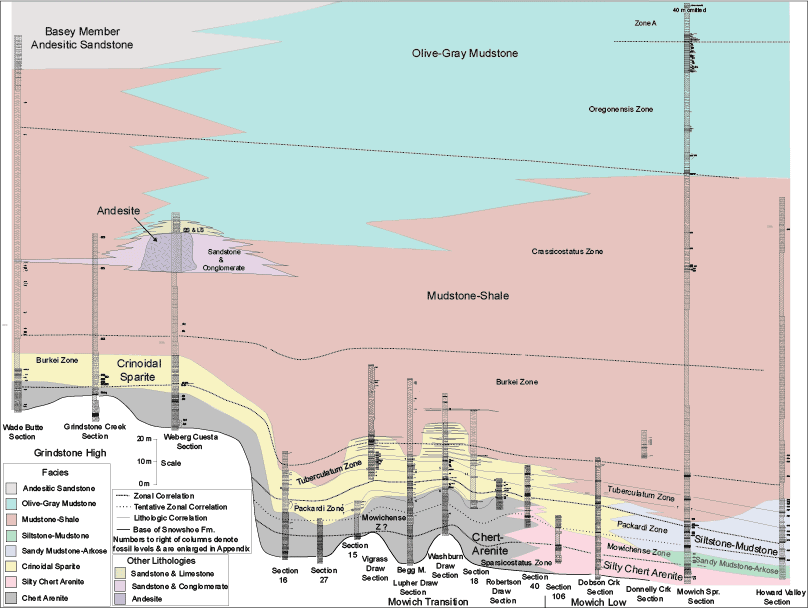
Click on thumbnail to enlarge the image.
Figure 2: Southern Transect, giving the distribution of the lithofacies within the basin.
Figure 3: Northern Transect, giving the distribution of the lithofacies within the basin. |
Crinoidal
Sparite Facies.- This
facies composes the upper division of the Weberg Member at most locations in the
northern transect (Fig. 3 ![]() ) and those sections west of and including section 40
in the southern transect (Fig. 2
) and those sections west of and including section 40
in the southern transect (Fig. 2 ![]() ). The following description emphasizes the facies in the southern transect
at the Mowich Transition (Fig. 2
). The following description emphasizes the facies in the southern transect
at the Mowich Transition (Fig. 2 ![]() ).
).
Lithologies are relatively nonresistant coarse sandy siltstone to very fine sandy sandstone with numerous thin, resistant, tabular or concretionary limestone beds 5 - 50 cm thick. The two principal sediment types are as follows.
The first is nonresistant lithologies of mature chert arenite, subordinate calcareous mature plagioclase arkose, and coarse siltstone. These are borderline between siltstone and sandstone. Fossils are rare. Terrigenous detritus typically ranges from medium silt through medium sand and is well sorted. Grain outlines are angular to subangular. Phyllosilicates comprise 2-4 percent of the rock. Minor amounts of calcite cement are present.
The second is resistant fossiliferous, coarse silty to very fine sandy crinoidal sparite. Beds in places show faint bedding and lamination. Bioturbation is pervasive and the burrows have vague boundaries, when individual burrows are discernable. Shell debris usually is oriented randomly as a result of bioturbation. Small size shell debris (shells to 1 cm long) commonly is concentrated in lentils, and around or in large ammonite shells. The rock is well sorted and the size range of the terrigenous component is medium silt to medium sand. Median diameter is in the very fine sand size class in the lower part of the facies, and coarse silt in its upper part. Terrigenous detritus is subangular to predominantly angular.
The terrigenous component comprises 10-35 percent of the rock. Volcanic and reworked sedimentary detritus is present in various degrees of mixing. Beds with abundant volcanic debris are most common high in the unit. There, albite may comprise 75 - 80 percent, altered volcanic fragments up to 20- 25 percent, and reworked quartz chert grains just a few percent of the rock. Beds with abundant sedimentary detritus are most common low in the unit. There, beds may have 40 - 45 percent chert, 40 - 45 percent quartz and little volcanic detritus. Clay constitutes less that 4 percent of the rock.
Much of the carbonate fraction is recrystallized circular crinoidal ossicles which, along with the terrigenous component, forms the framework of the rock. The ossicles comprise about 25 - 30 percent of the rock, while molluscan shell detritus, which is recrystallized to coarse blocky spar, accounts for 1 - 25 percent. The ossicles are recrystallized to medium to coarsely blocky spar, and while their boundaries are sharp, commonly they are partly dissolved. This detritus is somewhat coarser than the terrigenous component.
Following are remarks about the facies at other locations. Arkose beds are conspicuous at Camp Creek, Packard Draw, Swamp Creek, and Wade Butte. The top of the facies at the Swamp Creek Section is marked by a 2.7 m thick poorly sorted granule-bearing calcareous albite-rich arkose. At Wade Butte arkose beds are more common than elsewhere in the lower part of the facies. There, the arkose has granules comprising the coarsest 1 percent of siliciclastics; medium diameter is in the fine sand size class, and phyllosilicates may comprise several percent of the rock. The facies has few limestone beds at the Grindstone Creek, Weberg Cuesta, and Bedortha Ranch sections.
Sandy
Mudstone-Arkose Facies.- This facies occurs at
Mowich Spring and Howard Valley (Fig. 2 ![]() ). The
lithology is sandy mudstone to siltstone with intercalations of silty calcareous
arkose and subordinate silty calcareous arenite.
). The
lithology is sandy mudstone to siltstone with intercalations of silty calcareous
arkose and subordinate silty calcareous arenite.
This facies consists of about 85 percent nonresistant, non-laminated, dark gray mudstone to siltstone. Several beds of silty calcareous arkose and a few beds of silty calcareous chert arenite make up about 15 percent of the facies. The chert arenite lithology is identical to beds that are described under the silty chert arenite facies. The rocks are moderately to well sorted and muddy to finely sandy. They usually are calcareous, but the calcite content does not exceed 50 percent of the rock. Carbonate allochems include molluscan shell fragments and crinoid ossicles. The carbonate fraction composes 30-40 percent of the rock, and consists primarily of blocky spar with minor amounts of molluscan shell and crinoidal debris.
Siltstone-Mudstone Facies.- This facies occurs at Mowich Spring and Howard Valley. It is dominated by mudstone, many beds of which are sandy. It also includes muddy-silty plagioclase-rich arkose, to muddy-silty calcareous chert arenite and comparable siltstone. The coarser-grained beds are very fine sandy arenites. The siltstone and arenite are argillaceous and thoroughly bioturbated, like similar beds described from the silty chert arenite facies.
Mudstone-Shale Facies.- This facies makes up most of the Warm Springs Member. The strata are mostly thinly laminated. Fissile, laminated shale occurs at Wade Butte, notably in the lower part of the member. An albite-rich lithic arkose bed about 1 m thick occurs 70 m above the bases of the Snowshoe Formation there.
The lower several meters of this facies typically is transitional with the subjacent facies of the Weberg Member. These basal beds of the Warm Springs include very fine sandy mudstone and stilstone and are thin to medium-bedded. Laminations occur in these transitional beds, but are not so pervasive as in the overlying strata.
Olive-Gray Mudstone Facies.- This facies comprises the upper part of the Warm Springs member at numerous locations, especially above local submarine andesite flows. Thin parallel laminations predominate, and strata commonly are thinly bedded.
Andesitic Sandstone Facies.- This facies is composed of medium to thick beds of andesitic sandstone, with minor siltstone and mudstone. The beds are turbiditic fan deposits.
Being a volcaniclastic sequence in a marginal
continental setting it is expected that tuff beds would occur throughout the
Snowshoe Formation. There are fewer
of them in the lower Weberg, which represents a comparatively high-energy
shallow marine setting in which the ash in most cases would have been destroyed
by persistent wave and current action. As noted above, there are a few thicker
and or laterally persistent beds that were used for correlation between
stratigraphic sections (Figs. 4 ![]() - 5
- 5 ![]() - 6
- 6 ![]() ). This
was made possible by calibrating them to the ammonoid sequence. These beds (or units) are informally designated
"A" through "F" (Fig. 6
). This
was made possible by calibrating them to the ammonoid sequence. These beds (or units) are informally designated
"A" through "F" (Fig. 6 ![]() ). Some actually represent more than one eruptive event. For example unit F is composed of two quite closely spaced beds. These
tuffs help to permit precise correlation to those sections where the faunal
control may not be as good as it is in other sections. As expected, tuff beds
are most numerous in the facies of the "offshore" Warm Springs Member. At least some of the thicker ash beds from the lower part of the section
have a proximal source, as suggested by arkose beds at Swamp Creek and Packard
Draw at about the same level as tuff unit F at Camp Creek (Appendix
). Some actually represent more than one eruptive event. For example unit F is composed of two quite closely spaced beds. These
tuffs help to permit precise correlation to those sections where the faunal
control may not be as good as it is in other sections. As expected, tuff beds
are most numerous in the facies of the "offshore" Warm Springs Member. At least some of the thicker ash beds from the lower part of the section
have a proximal source, as suggested by arkose beds at Swamp Creek and Packard
Draw at about the same level as tuff unit F at Camp Creek (Appendix ![]() ).
).
At Mowich Spring one of the ash beds (Unit C) does not appear to project to other sections. There are a number of minor tuff beds in proximity with this unit as well as the superjacent ash bed D. As a result there is some potential for conflicted correlation using the tuff beds at this level. Care was taken, however, to rely primarily on the ammonoid correlation.
The tuff beds exhibit an interesting diagenetic alteration sequence. Many are composed of lithified clay (some partly altered to heulandite), heulandite, and laumontite. While most of the beds are composed of one rock type or another, some show two or all three at distinct levels in the same bed. It appears that clay represents the least diagenetic alteration, heulandite greater alteration and laumontite the greatest degree of alteration. While the tuffs are altered in part as a result of deep burial (Coombs, 1954; Coombs et al., 1959), the heulandite - laumontite association includes diagenetic factors other than pressure from deep burial (Boles, 1974; Boles & Coombs, 1977), as laumontite in the Weberg Member occurs in the Mowich Low but does not occur in the same beds in the Grindstone High or Mowich Transition.
Figure 4: Southern Transect, Grindstone High. |
Note that the tuff beds do not show up in all of the stratigraphic sections where they might be expected. In some cases parts of sections had to be cleared of loose surficial debris to expose the beds well. As the clayey tuffs in particular are recessive, they could have been missed readily if that part of section in which they occur was not excavated sufficiently. Therefore, some tuff beds might simply have been missed when measuring sections.
Figure 5: Southern Transect, Mowich Transition. |
The ammonoid biochronology for the lower part of
the Snowshoe Formation in the Suplee area (Fig. 7 ![]() ) was described in Taylor
(1988), who also provided correlation with zonations in Alaska, South America,
and Europe (Fig. 8
) was described in Taylor
(1988), who also provided correlation with zonations in Alaska, South America,
and Europe (Fig. 8 ![]() ). Zonal
terminology for Alaska was provided in Westermann (1964,
1969) and Hall
& Westermann (1980), and for South America in Westermann &
Riccardi (1972, 1979), Hillebrandt & Westermann
(1985),
and Dietz et al. (2010). Hillebrandt et al.
(1992)
provided a review of circum-Pacific zones. The ranges of the ammonoid species in each of the 22 measured
stratigraphic sections are given in the Appendix.
). Zonal
terminology for Alaska was provided in Westermann (1964,
1969) and Hall
& Westermann (1980), and for South America in Westermann &
Riccardi (1972, 1979), Hillebrandt & Westermann
(1985),
and Dietz et al. (2010). Hillebrandt et al.
(1992)
provided a review of circum-Pacific zones. The ranges of the ammonoid species in each of the 22 measured
stratigraphic sections are given in the Appendix.
This zonation is considered to be a discrete
biochronologic scale sensu Guex (1987,
1991) & Guex et al.
(2015). The chronologically diagnostic association for each zone is taken to be
those species which first appear, last appear, or are restricted to a given
zone. The "congregation" or chronologically diagnostic set of species can be
inferred readily from the composite range chart (Fig. 7 ![]() ).
).
Note that Figures 4 ![]() - 5
- 5 ![]() - 6
- 6 ![]() and 9
and 9 ![]() -
10
-
10 ![]() map the zones as
though they are stacked on one another, and in that sense are depicted as being "continuous". This is primarily
representational to show how the approximately time-equivalent packages of sediments filled the local basin. This is possible strictly on a local level in part because
lithological correlations can be made between certain distinctive beds,
including tuffs.
map the zones as
though they are stacked on one another, and in that sense are depicted as being "continuous". This is primarily
representational to show how the approximately time-equivalent packages of sediments filled the local basin. This is possible strictly on a local level in part because
lithological correlations can be made between certain distinctive beds,
including tuffs.
Figure 6: Southern Transect, Mowich Low. |
The thicker tuff beds described above, when considered along with the ammonoid sequence, do help to refine correlation between sections. In certain sections the limits of given zones are adjusted as tuff beds are used as an assessory means for correlation. For example, the basal-most beds of the Tuberculatum Zone, which yield poorly preserved Fontannesia, occur below a comparatively thick tuff bed. Where the faunal evidence for the basal-most Tuberculatum zone is lacking west of Robertson Draw Section, the tuff bed is used as a guide to draw the lower limit of the zone just below that bed.
Figure 7: Range chart of ammonoids from the study area. |
Figure 8: Correlation of late Aalenian and early Bajocian zones from the western United States and Alaska, South America, and Europe. |
We reemphasize that the actual definition of each zone is based on its chronologically diagnostic set of species, not on tuff or other beds that are helpful mainly for mapping purposes on a local level.
As noted in Taylor (1988) the Sparsicostatus
Zone is best developed in the Harris Place Section (Fig. 1 ![]() ;
Appendix
;
Appendix ![]() ), where it
occurs in both the lower and upper parts of the Weberg Member. The typical interval includes levels 0774 through 0667
(Appendix
), where it
occurs in both the lower and upper parts of the Weberg Member. The typical interval includes levels 0774 through 0667
(Appendix ![]() ).
While there is no locality that gives a superpositional relationship with
any lower fauna, the Mowich Spring Section does demonstrate that the zone is
subjacent to the Mowichense Zone (Figs. 6
).
While there is no locality that gives a superpositional relationship with
any lower fauna, the Mowich Spring Section does demonstrate that the zone is
subjacent to the Mowichense Zone (Figs. 6 ![]() & 9
& 9 ![]() ;
Appendix
;
Appendix ![]() ). In fact the type section for the Mowichense Zone is at Mowich
Spring (Figs. 6
). In fact the type section for the Mowichense Zone is at Mowich
Spring (Figs. 6 ![]() & 9
& 9 ![]() ), where it is documented
over a 4 m interval beginning 9.5 meters above the base of the section (levels
0859-0861;
Appendix
), where it is documented
over a 4 m interval beginning 9.5 meters above the base of the section (levels
0859-0861;
Appendix ![]() ).
).
Kovács (2009) allocated Planammatoceras vigrassi to Accardia, a genus established by Cresta (1977). The Oregon species is a close match to Accardia, although it lacks the oblique umbilical elements. For the time being the Oregon species is kept in Planammatoceras until it is more fully described.

Click on thumbnail to enlarge the image.
Figure 9: Southern Transect, giving the succession of the ammonoid zones within the basin.
Figure 10: Northern Transect, giving the succession of the ammonoid zones within the basin. |
The Packardi Zone (Taylor, 1988) has its
type locality in the Washburn Draw Section (Figs. 5 ![]() & 9
& 9 ![]() ;
Appendix
;
Appendix ![]() ), from
levels 0635 to 0569. While species
of Fontannesia are taken to help
characterize the zone, poorly preserved material at Robertson Draw and Mowich
Spring suggest that the genus ranges into the basal part of the superjacent
Tuberculatum Zone. Note
that at Mowich Spring, Planammatoceras
robertsoni and P. vigrassi are allocated
to the Packardi zone. This is
tentative in that, while they are in that part of the sequence where Packardi
Zone faunas is expected, these species do not co-occur with other species taken
to be diagnostic of the Zone.
), from
levels 0635 to 0569. While species
of Fontannesia are taken to help
characterize the zone, poorly preserved material at Robertson Draw and Mowich
Spring suggest that the genus ranges into the basal part of the superjacent
Tuberculatum Zone. Note
that at Mowich Spring, Planammatoceras
robertsoni and P. vigrassi are allocated
to the Packardi zone. This is
tentative in that, while they are in that part of the sequence where Packardi
Zone faunas is expected, these species do not co-occur with other species taken
to be diagnostic of the Zone.
The type locality for the Tuberculatum Zone (Taylor,
1988) is also at the Washburn Draw Section (Figs. 5 ![]() & 9
& 9 ![]() ;
Appendix
;
Appendix ![]() ). There the zone is well characterized from beds 0574 to 0612, although the
undiagnostic 0576 location is also included. The Tuberculatum Zone includes a
lower Westi Subzone and an upper Ochocoense Subzone, both having type localities
at the Washburn Draw Section. The
typical fossiliferous beds for the former are 0558 through 1139, and the typical
beds for the latter are 0565 through 0612. The Tuberculatum Zone is taken to persist a short stratigraphic distance
below tuff bed D (Fig. 5
). There the zone is well characterized from beds 0574 to 0612, although the
undiagnostic 0576 location is also included. The Tuberculatum Zone includes a
lower Westi Subzone and an upper Ochocoense Subzone, both having type localities
at the Washburn Draw Section. The
typical fossiliferous beds for the former are 0558 through 1139, and the typical
beds for the latter are 0565 through 0612. The Tuberculatum Zone is taken to persist a short stratigraphic distance
below tuff bed D (Fig. 5 ![]() ).
).
Material referable to Asthenoceras is exceptionally abundant and first appears in the Tuberculatum Zone (the genus persists to the Crassicostatus Zone). Two species described in Imlay (1973) as Fontannesia luculenta and F. intermedia are referable to Asthenoceras and are conspecific. They were described on the same page (Imlay, 1973, p. 57), with F. costula being described first. Taylor (1988) recognized A. costulum since it had line priority. At the same time Linares & Sandoval (1988) redescribed the species when working with material from Spain and made A. costulum a junior synonym of A. intermedium. They (Linares & Sandoval, op. cit.) are first revisers. Therefore, the material referred to A. costulum in Taylor (1988) is now allocated to A. intermedium.
"Docidoceras" lupheri has been allocated to the Tuberculatum Zone (Taylor, 1988). That species has been attributed to the genus Mollistephanus (Chandler & Dietz, 2004) and that genus, in turn, has been assigned to the new subfamily of Fernandez-Lopez & Pavia (2015), the Mollistephaninae.
The type section for the Burkei Zone is at Wade
Butte (Taylor, 1988) where is it well characterized from beds 0742
through 0767 near the exposed upper part of the Weberg Member (Figs. 4 ![]() & 9
& 9 ![]() ;
Appendix
;
Appendix ![]() ). Ammonoids at the Vigrass
Draw Section (Figs. 5
). Ammonoids at the Vigrass
Draw Section (Figs. 5 ![]() & 9
& 9 ![]() ;
Appendix
;
Appendix ![]() ) and Camp Creek Section
(Fig. 10
) and Camp Creek Section
(Fig. 10 ![]() ;
Appendix
;
Appendix ![]() ) are closely associated with tuff unit F. At those locations the base of the Burkei Zone appears to coincide
closely with that tuff unit.
) are closely associated with tuff unit F. At those locations the base of the Burkei Zone appears to coincide
closely with that tuff unit.
Freboldites bifurcatus, which occurs in the Burkei Zone, has recently been referred to a new subfamily, Frebolditinae, of Fernandez-Lopez & Pavia (2015).
The Crassicostatus Zone was originally defined in Hall
& Westermann (1980), with the type area at Cook Inlet in southern
Alaska. They (Hall & Westermann,
op. cit.) recognized that ammonoids
within the "middle part" of the Warm Springs Member (including Parabigotites
crassicostatus) are referable to their new zone. The Crassicostatus Zone in Oregon is best represented at Wade Butte
(Figs. 4 ![]() & 9
& 9 ![]() ;
Appendix
;
Appendix ![]() ), Grindstone Creek
(Figs. 4
), Grindstone Creek
(Figs. 4 ![]() &
9
&
9 ![]() ;
Appendix
;
Appendix ![]() ),
Weberg Cuesta (Figs. 4
),
Weberg Cuesta (Figs. 4 ![]() & 9
& 9 ![]() ;
Appendix
;
Appendix ![]() ), and Mowich Spring
(Figs. 6
), and Mowich Spring
(Figs. 6 ![]() &
9
&
9 ![]() ;
Appendix
;
Appendix ![]() ). Stephanoceras
(Phaulostephanus ?) oregonense
Imlay (1973), from the Crassicostatus Zone, has recently been
re-allocated to a new genus, Paramollistephanus
(Fernandez-Lopez & Pavia, 2015) which in turn is attributed to
their (Fernandez-Lopez & Pavia,
op.
cit.) new subfamily, the Mollistephaninae. The genus Parabigotites is also
referred to a new subfamily (Fernandez-Lopez & Pavia, op.
cit.), the Frebolditinae.
). Stephanoceras
(Phaulostephanus ?) oregonense
Imlay (1973), from the Crassicostatus Zone, has recently been
re-allocated to a new genus, Paramollistephanus
(Fernandez-Lopez & Pavia, 2015) which in turn is attributed to
their (Fernandez-Lopez & Pavia,
op.
cit.) new subfamily, the Mollistephaninae. The genus Parabigotites is also
referred to a new subfamily (Fernandez-Lopez & Pavia, op.
cit.), the Frebolditinae.
The Oregonensis Zone originally was allocated as a subzone of the Kirschneri Zone (Taylor, 1988). The Kirschneri Zone is an assemblage zone of tremendous scope (Hall & Westermann, 1980). Only the upper subzone is reasonably defined. As such, we elevate the Richardsoni to zonal status, and leave subjacent horizons for subsequent definition. As a result the Oregonensis beds are elevated to zonal status.
The Oregonensis Zone is well documented at Mowich
Spring (Fig. 9 ![]() ;
Appendix
;
Appendix ![]() ) where it occurs in the olive-gray laminated mudstones
of the Warm Springs Member, from levels 0534 through 0662. There the highly variable species Dorsetensia oregonensis is exceptionally common.
Emileia aff. contracta
is a reasonably common associate.
) where it occurs in the olive-gray laminated mudstones
of the Warm Springs Member, from levels 0534 through 0662. There the highly variable species Dorsetensia oregonensis is exceptionally common.
Emileia aff. contracta
is a reasonably common associate.
An undetermined superjacent "zone" (= Zone A) is
documented at Mowich Spring from levels 0504 and 0795/0796 (Fig. 9 ![]() ;
Appendix
;
Appendix ![]() ).
In that part of the section Dorsetensia
oregonensis ranges above Emileia. A diagnostic associate includes an involute Dorsetensia
n. sp.
).
In that part of the section Dorsetensia
oregonensis ranges above Emileia. A diagnostic associate includes an involute Dorsetensia
n. sp.
Figures 2 ![]() - 3
- 3 ![]() reveal the spatial-temporal
relationships of the facies in the basin. The silty chert arenite facies was the
first to be deposited and is restricted to the Mowich Low where it overlies the
Mowich Group with little angular discordance. While the facies does not have
abundant coarse-grained detritus, paucity of arkose and tuff beds along with its
position at the base of the transgressive sequence suggest it was deposited in a
comparatively high-energy regime or at least one with persistent current and
wave activity. The fine-grained
nature of the facies most likely resulted from lack of local paleotopographic
relief and a source for plentiful coarse-grained detritus. Upsection in the Mowich Low there occurred a progressive
change to more argillaceous sediments laid down in quieter water conditions.
reveal the spatial-temporal
relationships of the facies in the basin. The silty chert arenite facies was the
first to be deposited and is restricted to the Mowich Low where it overlies the
Mowich Group with little angular discordance. While the facies does not have
abundant coarse-grained detritus, paucity of arkose and tuff beds along with its
position at the base of the transgressive sequence suggest it was deposited in a
comparatively high-energy regime or at least one with persistent current and
wave activity. The fine-grained
nature of the facies most likely resulted from lack of local paleotopographic
relief and a source for plentiful coarse-grained detritus. Upsection in the Mowich Low there occurred a progressive
change to more argillaceous sediments laid down in quieter water conditions.
The chert arenite facies makes up the basal Weberg
to the west. The heterogeneous
lithology of the facies reflects the varied conditions under which it was
deposited. At the Mowich Transition (Figs. 5 ![]() & 9
& 9 ![]() ) subjacent Triassic rocks include steeply inclined mudstone and
conglomerate lithologies that had been eroded into an irregular topography prior
to Snowshoe deposition. These
Triassic sediments furnished an abundant supply of terrigenous detritus. Conglomerates (and sandstones) in sections 16 & 27
(Fig. 5
) subjacent Triassic rocks include steeply inclined mudstone and
conglomerate lithologies that had been eroded into an irregular topography prior
to Snowshoe deposition. These
Triassic sediments furnished an abundant supply of terrigenous detritus. Conglomerates (and sandstones) in sections 16 & 27
(Fig. 5 ![]() ) may have been shed from the Grindstone High. The topographic irregularity at Harris Place
(Fig. 3
) may have been shed from the Grindstone High. The topographic irregularity at Harris Place
(Fig. 3 ![]() ) likely resulted
from faulting just prior to Snowshoe deposition. The angularity of the grains composing the chert arenite
facies indicates that the sediments were not subject to prolonged periods of
abrasion. Nevertheless, the paucity
of fines and abundance of coarse detritus is consistent with reworking and
high-energy conditions. The
proposed high-energy regime is support by the lack of tuff beds and paucity of
arkose beds, which are present laterally in offshore facies.
) likely resulted
from faulting just prior to Snowshoe deposition. The angularity of the grains composing the chert arenite
facies indicates that the sediments were not subject to prolonged periods of
abrasion. Nevertheless, the paucity
of fines and abundance of coarse detritus is consistent with reworking and
high-energy conditions. The
proposed high-energy regime is support by the lack of tuff beds and paucity of
arkose beds, which are present laterally in offshore facies.
The crinoidal sparite facies is superjacent to the chert arenite facies. Paucity of clay and presence of lenticular beds of small-size shell debris indicate modest currents and/or wave agitation. Vague boundaries of the bioturbation structures reflect soft sediment. Calcite-rich sediment characteristic of the facies continued to be deposited in the Mowich Transition so long as there was any continued expression of local pre-Snowshoe topographic highs. Terrigenous muds spread uniformly across the sea floor above the crinoidal sparite facies only after topographic relief was eliminated.
The chert arenite and crinoidal sparite facies transgressed westward onto the Grindstone High, so that the first sediments of the former there were deposited during The Tuberculatum Zone and those of the latter during the latest Tuberculatum Zone to Burkei Zone.
Uniform sedimentation of the mudstone-shale facies across the Suplee Platform was attained by Crassicostatus time. The fine-grained texture of the mudstone facies and occurrence in it of numerous tuff beds indicate quiet water. The Olive-gray mudstone facies is closely associated with andesitic volcanics in its lower part and sandy turbidites of the Basey in its upper part.
In summary, the facies distribution reflects a westward transgression and filling in of a locally complex paleotopography. Sediments become finer-grained upsection at any locality and from west to east. That is, progression in those directions reflect changes from higher to lower energy regimes and a deepening of the ocean bottom. These relationships are important because they provide the framework for the nearshore-offshore trends in faunal distributional patterns in the basin (Taylor, 1982).
Thrusting along the Camp Creek Fault prior to the Snowshoe Formation raised the Grindstone High by 50-70 m or more.
The lower four ammonoid zones are comparatively thin. This might reflect input of predominantly terrigenous detritus reworked notably from upper Triassic and older basement rocks. The later Burkei, Crassicostatus, and Oregonensis zones are thicker, possibly as volcaniclastic sedimentation rates picked up. These relationships, of course, cannot be verified without the assistance of radiometric age dating.
The Basey Member at Wade Butte is of interest because the sandstones there are notably calcareous. Also, the olive-gray mudstones do not persist as far west as Wade Butte. These observations indicate that the upper Warm Spring and Basey there may have been deposited a slight topographic high compared to the equivalent beds in the Mowich Low.
Parts of the Warm Springs Member, especially those beds close to the superjacent Basey, likely includes distal fan facies, while the Basey itself is a mid-fan unit (Dickinson & Vigrass, 1965).
The Weberg sediments with their diverse benthic shelly faunas were deposited in a shallow marine setting (Taylor, 1982). A depth range to about a 100 m is consistent with that proposed for similar faunas in Europe (Hallam, 1975). Weberg sediments of the Burkei Zone on the Grindstone High clearly are facies equivalent to fine-grained mudstone of the Warm Springs Member at Mowich Spring. The Snowshoe Formation is not olistostromal and there is no indication that palinspastic reconstruction is needed to materially adjust the relative positions of the stratigraphic sections measured in the area. Lacking evidence for a steep gradient (except perhaps locally at the Camp Creek Fault) it is, therefore, most likely that the lower Warm Springs Member was deposited in waters not markedly more than a couple hundred meters.
Similarly, the short-term re-establishment of
carbonate-rich sandstone on top of the 20 m thick andesite flow at Weberg Cuesta
(Figs. 2 ![]() & 4
& 4 ![]() ) suggests a comparatively shallow-water setting rather than an
exceptionally deep basin.
) suggests a comparatively shallow-water setting rather than an
exceptionally deep basin.
Blome & Nestell (1991) considered that the Warm Springs Member was deposited in a deeper water setting than inferred in Taylor (1982) by arguing that samples with abundant and diverse radiolarian faunas from that member indicate a basin plain to distal fan environment. This paper maintains a shallow water setting for the lower Warm Springs, namely because of basin geometry, and because the Weberg faunas can be tied to a bathymetric frame of reference, a former strand line. Samples with abundant and diverse radiolaria only ensure an open marine environment, not necessarily a deep-water one. The lower Warm Springs may not even be composed of sediments contributed from fan lobes. Moreover, while submarine fans predominate in deep water (several hundreds of meters or more) great water depths are not necessarily a requirement and they may be shallow water as well (Normandeau et al., 2013, 2015; Warrick et al., 2013; Scasso et al., 1991). While parts of the Warm Springs, as well as most of the Snowshoe Formation in the Izee area, certainly represent environments much deeper than the couple of hundred meters or so suggested herein for the basal Snowshoe transgressive sequence in Suplee, it is beyond the purpose of this report to evaluate those deeper settings.
Developing biochronologies in complex depositional conditions can lead to uncertainties of range relationships of fossil species. This work shows that a multidisciplinary approach using closely spaced stratigraphic sections, along with accessory correlation with tuff beds, can result in a refined representation of range relationships of species.
Incorporating the biochronology along with lithofacies relationships renders an understanding of basinal infilling difficult to achieve otherwise.
The ammonoid biochronology in the richly fossiliferous Snowshoe Formation on the Suplee Platform offers a standard of reference for the late Aalenian and part of the early Bajocian in the North American Western Cordillera. The succession offers close correlation with equivalent successions in South America and Europe.
The author is greatly indebted to the landowners on whose properties I have worked over the years. Among them are the late Melvin Weberg, Lawrence Weberg, Bill Weberg, the late Hugh Robertson, Les Robertson, the late Les Schnabele, Richard Bedortha and Gary Bedortha and their families. I am greatly indebted to them all for their kindness and generous hospitality. My appreciation is extended to the many students who have helped with the project. This work has benefited greatly by discussions with Paul Smith and Beth Carter. I thank Jean Guex and Terry Poulton for reviewing the paper. My thanks go to the late Ralph Imlay who assisted and encouraged me as I began my work on Jurassic studies and this project.
Blome C.D., Jones D.L., Benita L.M. & Liniecki M. (1986).- Geologic implications of radiolarian-bearing Paleozoic and Mesozoic rocks from the Blue Mountains Province, eastern Oregon. In: Vallier T.L. & Brooks H.C. (eds.), Geology of the Blue Mountains Province, eastern Oregon, Idaho, and Washington; paleontology and biostratigraphy.- United States Geological Survey Professional Paper 1435, p. 79-93.
Blome C.D. & Nestell M.K. (1991).- Evolution of a Permo-Triassic sedimentary mélange, Grindstone terrane, east-central Oregon.- Geological Society of America Bulletin, vol. 103, p. 1280-1296.
Boles J.R. (1974).- Structure, stratigraphy, and petrology of mainly Triassic rocks, Hokonui Hills, Southland, New Zealand.- New Zealand Journal of Geology & Geophysics, vol. 17, no. 2, p. 337-374.
Boles J.R. & Coombs D.S. (1977).- Zeolite facies alteration of sandstones in the Southland Syncline, New Zealand.- American Journal of Science, vol. 277, p. 982-1012.
Buddenhagen H.J. (1967).- Structure and orogenic history of the southwestern part of the John Day uplift, Oregon.- The Ore Bin, Portland, vol. 29, no. 7, p. 129-138. URL: http://www.oregongeology.org/pubs/og/OBv29n07.pdf
Chandler R.B. & Dietz V. (2004).- New data on the Lower Bajocian (Middle Jurassic) ammonite genus Mollistephanus Buckman, 1922 from southern England.- Proceedings of the Geologists' Association, vol. 115, p. 221-234.
Coney P.J. (1981).- Accretionary tectonics in western North America.- Arizona Geological Society Digest, vol. 14, p. 23-37.
Coney P.J., Jones D.L. & Monger J.W.H. (1980).- Cordilleran suspect terranes.- Nature, vol. 288, no. 5789, p. 329-333.
Coombs D.S. (1954).- The nature and alteration of some Triassic sediments from Southland, New Zealand.- Transactions of the Royal Society of New Zealand, vol. 82, p. 65-109.
Coombs D.S., Ellis A.J., Fyfe W.S. & Taylor A.M. (1959).- The zeolite facies, with comments on the interpretation of hydrothermal syntheses.- Geochimica et Cosmochimica Acta, vol. 17, p. 53-107.
Cresta S. (1997).- Hammatoceratidi aaleniani di Monte Erice (Sicilia occidentale, Italia).- Bolletino del Servizio Geologico d'Italia, vol. 114 (1995), p. 27-56.
Dickinson W.R. (1979).- Mesozoic forearc basin in central Oregon.- Geology, vol. 7, p. 166-170.
Dickinson W.R. & Vigrass L.W. (1965).- Geology of the Suplee-Izee area, Crook, Grant, and Harney counties, Oregon.- Oregon Department of Geology and Mineral Industries Bulletin, Portland, no. 58, 109 p. URL: http://www.oregongeology.org/pubs/B/B-058.pdf
Dickinson W.R. & Thayer T.P. (1978).- Paleogeographic and paleotectonic implications of Mesozoic stratigraphy and structure in the John Day Inlier of central Oregon. In: Howell D.G. & Mcdougall K.A. (eds.), Mesozoic paleogeography of the western United States.- Society of Economic Paleontologists and Mineralogists, Pacific Section Paleogeography Symposium 2, p. 147-161.
Dietz V., Hillebrandt A. von, Joly B., Riccardi A. & Schweigert G. (2010).- Ammonite faunas and stratigraphy of the Lower Bajocian of Paso del Espinacito (Middle Jurassic, San Juan Province, Argentina).- Palaeodiversity, vol. 3, 33 p.
Dorsey R.J. & Lamaskin T.A. (2007).- Stratigraphic record of Triassic-Jurassic collisional tectonics in the Blue Mountains Province, northeastern Oregon.- American Journal of Science, vol. 307, no. 10, p. 1167-1193.
Fernandez-Lopez S.R., & Pavia G. (2015).- Mollistephaninae and Frebolditinae, new subfamilies of Middle Jurassic stehanoceratid Ammonoidea.- Paläontologische Zeitschrift, vol. 89, no. 4, p. 707-727.
Guex J. (1987).- Corrélations biochronologiques et associations unitaires.- Presses Polytechniques Romandes, Neuchatêl, 250 p.
Guex J. (1991).- Biochronological Correlations.- Springer Verlag, Berlin, 252 p.
Guex J., Galster F. & Hammer Ø. (2015).- Discrete biochronological time scales.- Springer Verlag, Berlin, 160 p.
Hall R. & Westermann G.E.G. (1980).- Lower Bajocian (Jurassic) cephalopod faunas from western Canada and proposed assemblage zones for the lower Bajocian of North America.- Palaeontographica Americana, vol. 9, no. 52, 93 p.
Hallam A. (1975).- Jurassic Environments.- Cambridge, England, Cambridge University Press, 269 p.
Hillebrandt A. von & Westermann G.E.G. (1985).- Aalenian (Jurassic) Ammonite faunas and zones of the southern Andes.- Zitteliana, vol. 12, p. 3-55.
Hillebrandt A. von, Smith P., Westermann G.E.G. & Callomon J.H. (1992).- Ammonite zones of the circum-Pacific region. In: Westermann G.E.G. (ed.), The Jurassic of the Circum-Pacific.- Cambridge University Press, p. 247-272.
Imlay R.W. (1973).- Middle Jurassic (Bajocian) ammonites from eastern Oregon.- United States Geological Survey Professional Paper 756, 100 p. (47 Pls.).
Imlay R.W. (1980).- Jurassic Paleobiogeography of the conterminous United States in its continental setting.- United States Geological Survey Professional Paper 1062, 134 p.
Kovács Z. (2009).- Toarcian-Aalenian Hammatoceratinae (Ammonitina) from the Gerecse Mts (NE Transdunabian Range, Hungary).- Fragmenta Palaeontologica Hungarica, Budapest, vol. 27, p. 1-72.
Lamaskin T.A., Schwartz J.J., Dorsey R.J., Snoke A.W., Johnson K. & Vervoort J.D. (2009).- Mesozoic sedimentation, magmatism, and tectonics in the Blue Mountains Province, northeastern Oregon. In: O'Connor J.E., Dorsey R.J. & Madin I.P. (eds.), Volcanoes to vineyards: Geologic field trips through the dynamic landscape of the Pacific Northwest.- Geological Society of America Field Guide 15, 17 p.
Lamaskin T.A., Vervoort J.D., Dorsey R.J. & Wright J.E. (2011).- Early Mesozoic paleogeography and tectonic evolution of the western United States: Insights from detrital zircon U-Pb geochronology, Blue Mountains Province, northeastern Oregon.- Geological Society of America Bulletin, vol. 123, no. 9/10, p. 1939-1965.
Lamaskin T.A., Dorsey R.J., Vervoort J.D., Schmitz M.D., Tumpane K.P. & Moore N.O. (2015).- Westward growth of Laurentia by pre-Late Jurassic terrane accretion, eastern Oregon and western Idaho, United States.- The Journal of Geology, vol. 123, p. 233-267.
Linares A. & Sandoval J. (1988).- Asthenoceras y Fontannesia (Grammoceratinae ?, Ammonitina) del tránsito Aalense-Bajocense de la zona subbética (sur de España).- Revista Española de Paleontología, vol. 3, p. 3-11.
Lupher R.L. (1941).- Jurassic stratigraphy of central Oregon.- Geological Society of America Bulletin, vol. 52, no. 2, p. 219-270.
Normandeau A., Lajeunesse P. & St-Onge G. (2013).- Shallow-water longshore drift-fed submarine fan deposition (Moisie River Delta, Eastern Canada).- Geo-Marine Letters, vol. 33, p. 391-403.
Normandeau A., Lajeunesse P. & St-Onge G. (2015).- Submarine canyons and channels in the Lower St. Lawrence Estuary (Eastern Canada): Morphology, classification and recent sediment dynamics.- Geomorphology, vol. 241, p. 1-18.
Packard E.L. (1928).- A new section of Paleozoic and Mesozoic rocks in central Oregon.- American Journal of Science, vol. 215, p. 221-224.
Poulton T.P., Detterman R.L., Hall R. L., Jones D.L., Peterson J.A., Smith P., Tipper D.G., Tipper H.W., & Westermann G.E.G. (1992).- Western Canada and United States. In: Westermann G.E.G. (ed.), The Jurassic of the Circum-Pacific.- Cambridge University Press, p. 29-92.
Scasso R.A., Olivero E.B. & Buatois L.A. (1991).- Lithofacies, biofacies, and ichnoassemblage evolution of a shallow submarine volcaniclastic fan-shelf depositional system (Upper Cretaceous, James Ross Island, Antarctica).- Journal of South American Earth Sciences, vol. 4, no. 3, p. 239-260.
Smith P.L. (1980).- Correlation of the members of the Snowshoe Formation in the Izee basin of east-central Oregon.- Canadian Journal of Earth Sciences, vol. 17, no. 12, p. 1603-1608.
Taylor D.G. (1982).- Jurassic shallow marine invertebrate depth zones, with exemplification from the Snowshoe Formation, Oregon.- Oregon Geology, Portland, vol. 44, no. 5, p. 51-56. URL: http://www.oregongeology.org/pubs/og/OGv44n05.pdf
Taylor D.G. (1988).- Middle Jurassic (late Aalenian and early Bajocian) ammonite biochronology of the Snowshoe Formation, Oregon.- Oregon Geology, Portland, vol. 50, no. 11/12, p. 123-138. URL: http://www.oregongeology.org/pubs/og/OGv50n11-12.pdf
Taylor D.G., Callomon J.H., Hall R., Smith P.L., Tipper H.W. & Westermann G.E.G. (1984).- Jurassic ammonite biogeography of western North America: the tectonic implications. In: Westermann G.E.G. (ed.), Jurassic-Cretaceous biochronology and paleogeography of North America.- Geological Association of Canada, Special Paper 27, p. 121-142.
Warrick J.A., Simms A.R., Ritchie A., Steel E., Dartnell P., Conrad J.E. & Finlayson D.P. (2013).- Hyperpycnal plume-derived fans in the Santa Barbara Channel, California.- Geophysical Research Letters, vol. 40, p. 1-6.
Westermann G.E.G. (1964).- The ammonite fauna of the Kialagvik Formation at Wide Bay, Alaska Peninsula. Part I. Lower Bajocian (Aalenian).- Bulletins of American Paleontology, vol. 47, no. 216, p. 325-503.
Westermann G.E.G. (1969).- The ammonite fauna of the Kialagvik Formation at Wide Bay, Alaska Peninsula. Part II. Sonninia sowerbyi Zone (Bajocian).- Bulletins of American Paleontology, vol. 57, no. 255, 266 p.
Westermann G.E.G. & Riccardi A.C. (1972).- Middle Jurassic ammonoid fauna and biochronology of the Argentine-Chilean Andes. Part I: Hildocerataceae.- Palaeontographica, Abteilung A, vol. 140, p. 1-116 (31 Pls.).
Westermann G.E.G. & Riccardi A.C. (1979).- Middle Jurassic ammonoid fauna and biochronology of the Argentine-Chilean Andes. Part II: Stephanocerataceae.- Palaeontographica, Abteilung A, vol. 164, p. 85-188 (28 Pls.).
Figure 1 ![]() gives the location of each of the stratigraphic sections below. Numbers to
right of stratigraphic columns denote fossiliferous levels/beds.
gives the location of each of the stratigraphic sections below. Numbers to
right of stratigraphic columns denote fossiliferous levels/beds.
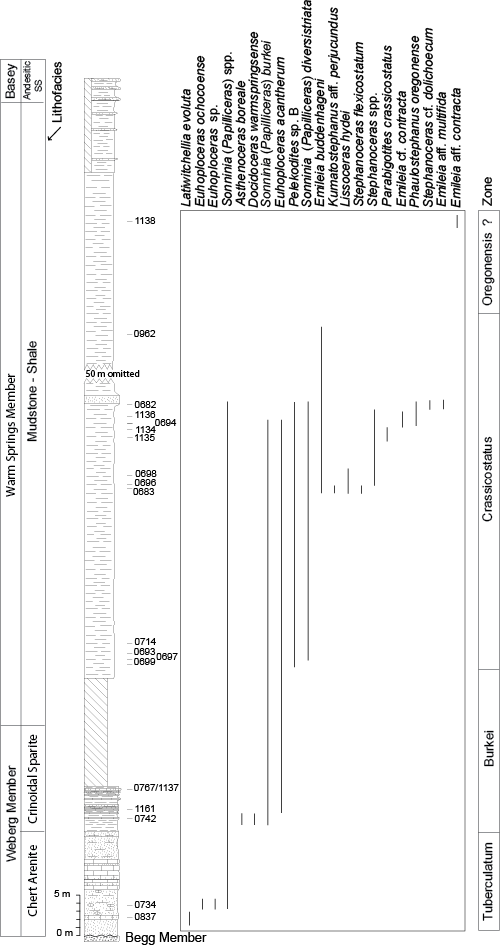
Click on thumbnail to enlarge the image.
Location 1.- Stratigraphic section at Wade Butte. The Weberg Member there unconformably overlies Carnian Vester Formation.
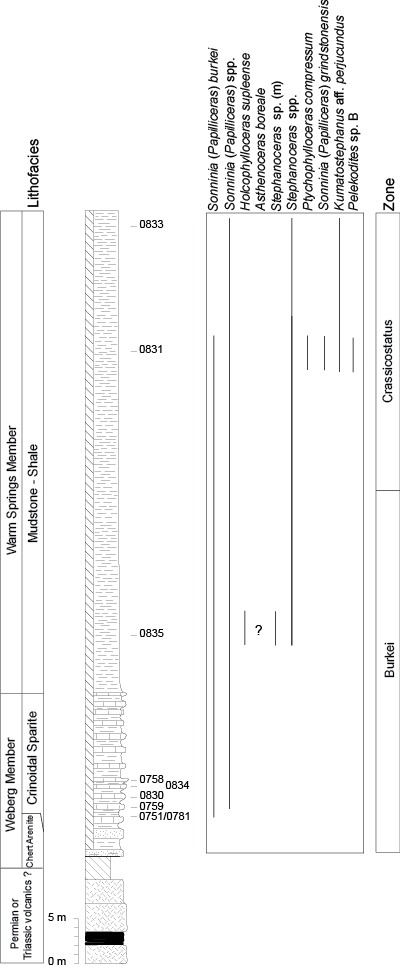
Click on thumbnail to enlarge the image.
Location 2.- Stratigraphic section at Grindstone Creek. The Weberg Member there unconformably overlies mélange material of Permian or Triassic age. The holotype of Sonninia (Papilliceras) grindstonensis (Taylor, 1988) is from level 0831.
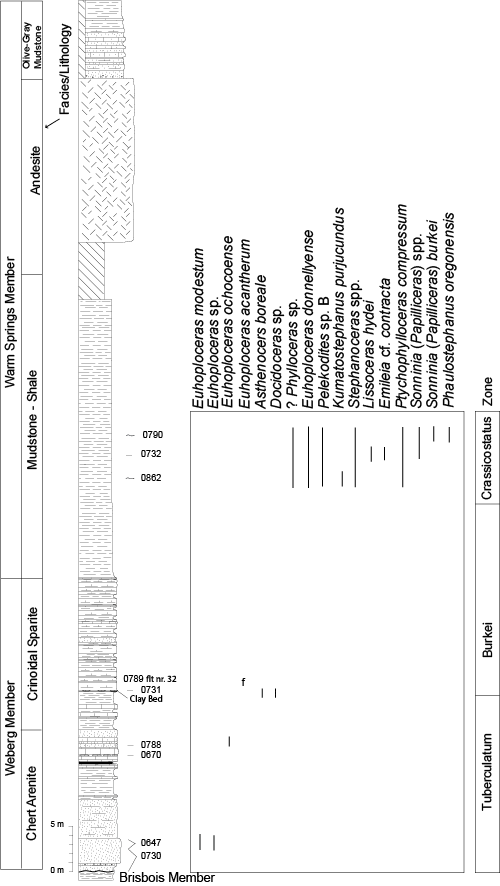
Click on thumbnail to enlarge the image.
Location 3.- Stratigraphic section at Weberg Cuesta. The Weberg Member there unconformably overlies the Carnian Brisbois Member, Vester Formation. "f" in range chart refers to float specimen.
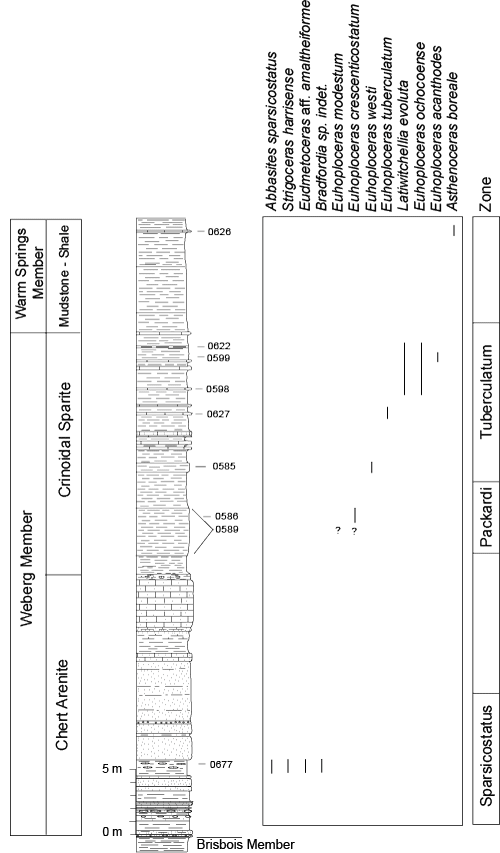
Click on thumbnail to enlarge the image.
Location 4.- Section 16. The Weberg Member there is in fault contact with the underlying Carnian Brisbois Member, Vester Formation. The fault runs along the bedding plane of the basal-most exposed bed of the Weberg. "f" in range chart refers to float specimens.
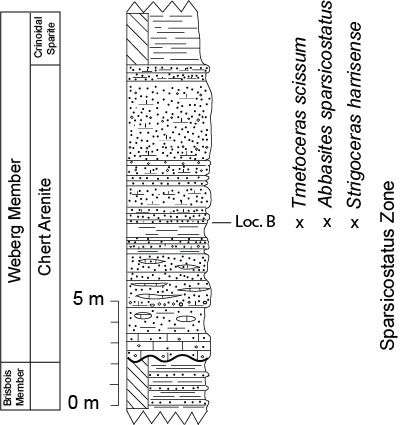
Click on thumbnail to enlarge the image.
Location 5.- Section 27. The Weberg Member there unconformably overlies the Carnian Brisbois Member, Vester Formation.
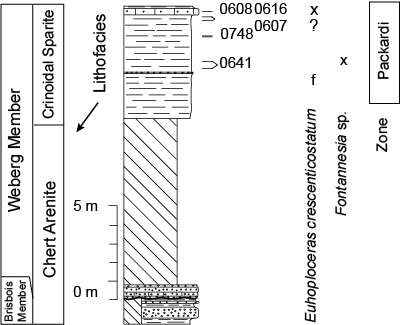
Click on thumbnail to enlarge the image.
Location 6.- Section 15. The Weberg Member there unconformably overlies the Carnian Brisbois Member, Vester Formation. "f" in range chart refers to float specimens.

Click on thumbnail to enlarge the image.
Location 7.- The Vigrass Draw section, in upper Weberg and lower Warm Springs members. Holotype of Euhoploceras grantense (Taylor, 1988) from bed 0570.
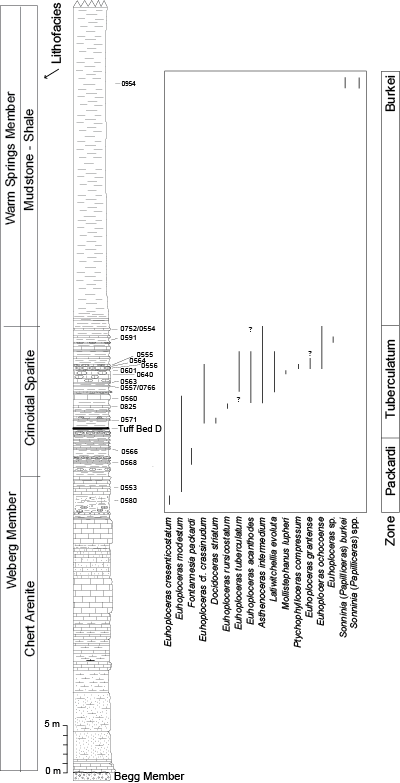
Click on thumbnail to enlarge the image.
Location 8.- Lupher Draw Section. The Weberg there unconformably overlies the Carnian Begg Member, Vester Formation. Tuff bed D was found at a later date than when the section was measured originally. Holotypes of Euhoploceras rursicostatum and Docidoceras striatum (Taylor, 1988) from levels 0825 and 0571 respectively.
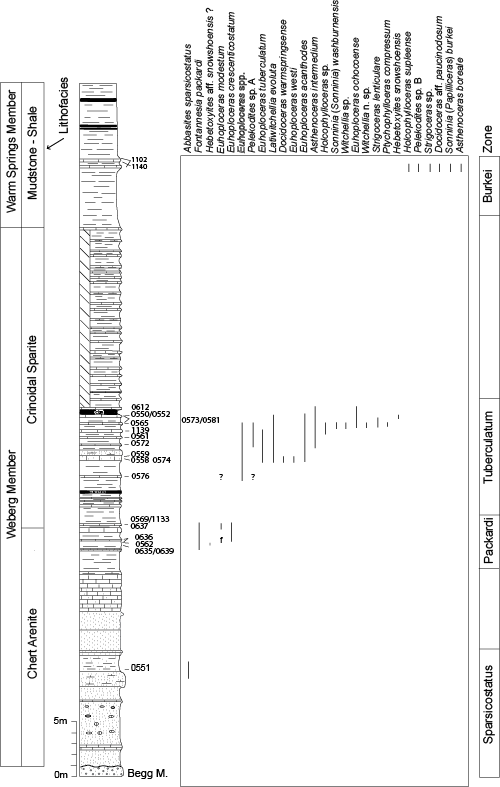
Click on thumbnail to enlarge the image.
Location 9.- Washburn Draw Section. The Weberg there unconformably overlies the Carnian Begg Member, Vester Formation. Holotypes of Ptychophylloceras compressum, Sonninia washburnensis, Euhoploceras ochocoense, Strigoceras lenticulare, and Hebetoxyites snowshoensis (Taylor, 1988) from beds 1139, 0565, 0573, 0581 & 0550 respectively.
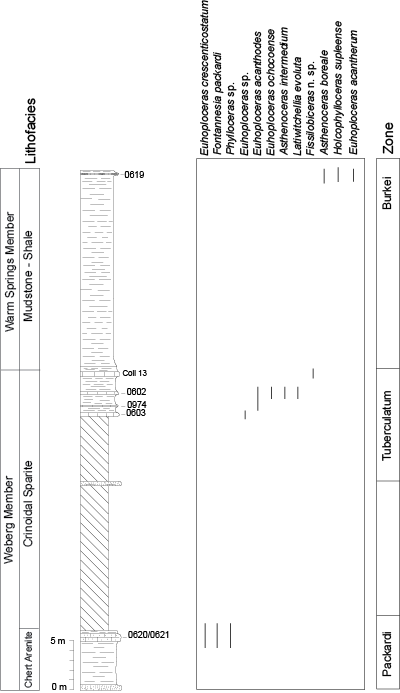
Click on thumbnail to enlarge the image.
Location 10.- Section 18, includes the Weberg and lower Warm Springs members.
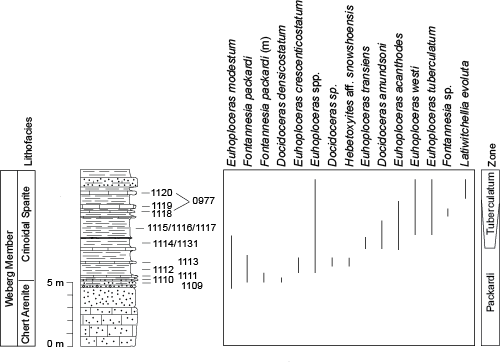
Click on thumbnail to enlarge the image.
Location 11.- Robertson Draw Section includes the middle part of the Weberg Member. Holotype of Euhoploceras transiens (Taylor, 1988) from the 1114/1131 horizon, holotype of Euhoploceras westi (Taylor, 1988) from level 0977, and holotype of Docidoceras amundsoni (Taylor, 1988) from the basal Tuberculatum Zone at this location.
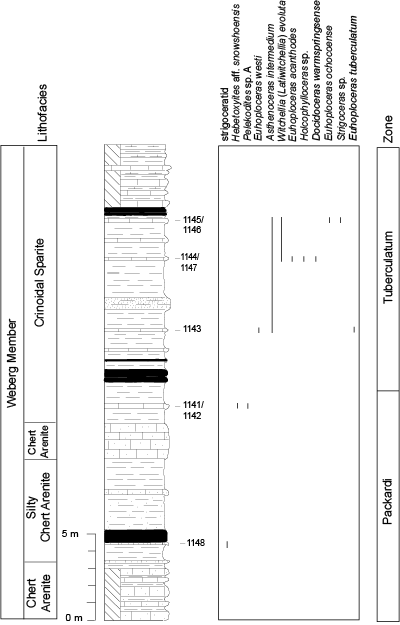
Click on thumbnail to enlarge the image.
Location 12.- Section 40 includes middle to upper parts of the Weberg Member.
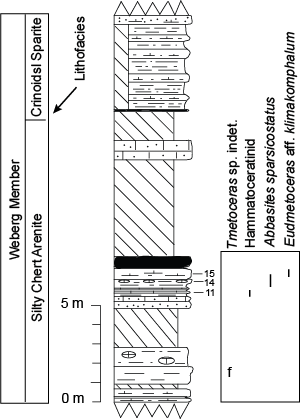
Click on thumbnail to enlarge the image.
Location 13.- Section 106 includes parts of the lower and upper divisions of the Weberg Member.
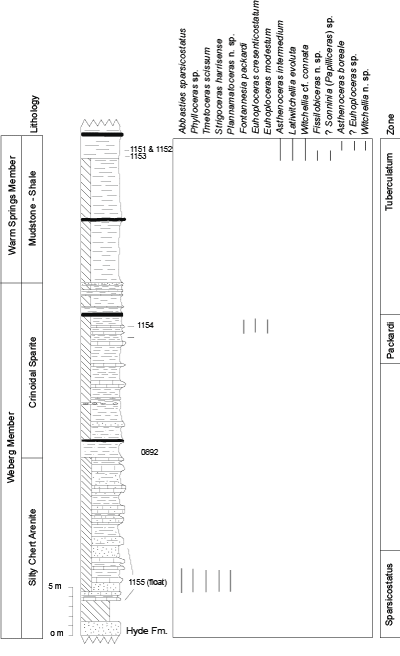
Click on thumbnail to enlarge the image.
Location 14.- The Weberg Member at Dobson Creek unconformably overlies the lower Jurassic Hyde Formation.

Click on thumbnail to enlarge the image.
Location 15.- The Donnelly Creek section, lower part the Warm Springs Member.
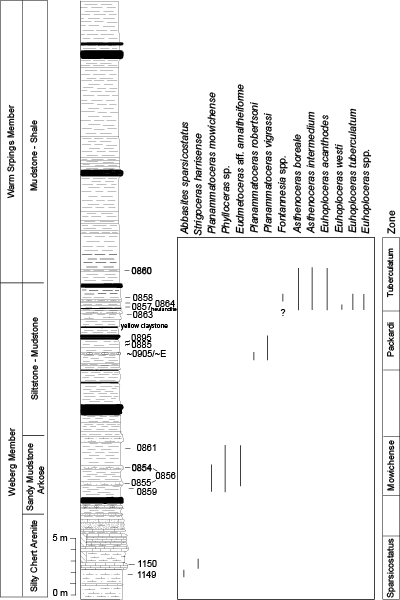
Click on thumbnail to enlarge the image.
Location 16a.- Lower part of Mowich Spring section includes much of the Weberg Member and lower part of the Warm Springs Member. Holotypes of Planammatoceras mowichense, P. vigrassi, and P. robertsoni (Taylor, 1988) from levels 0856, 0895, and "E" respectively.
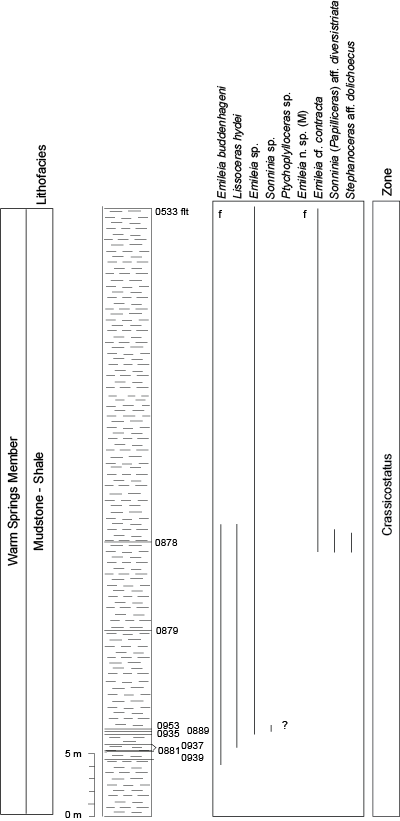
Click on thumbnail to enlarge the image.
Location 16b.- Middle part of Mowich Spring section includes middle parts of the Warm Springs Member. "f" in range chart refers to float specimens.
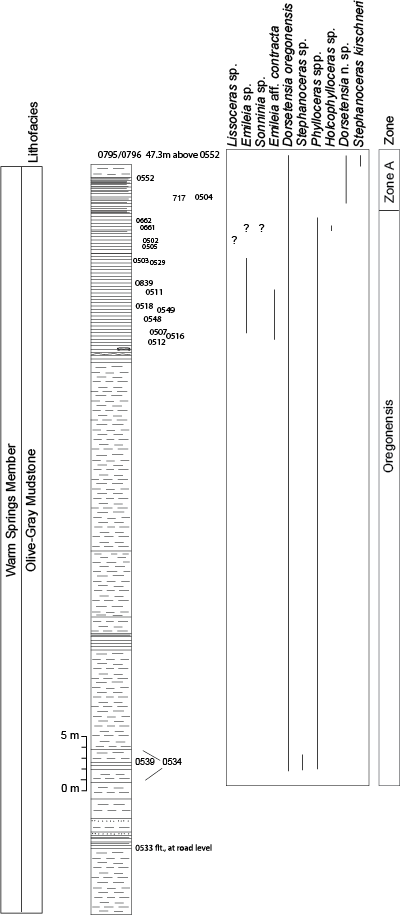
Click on thumbnail to enlarge the image.
Location 16c.- Upper Mowich Spring Section with olive-gray mudstones.
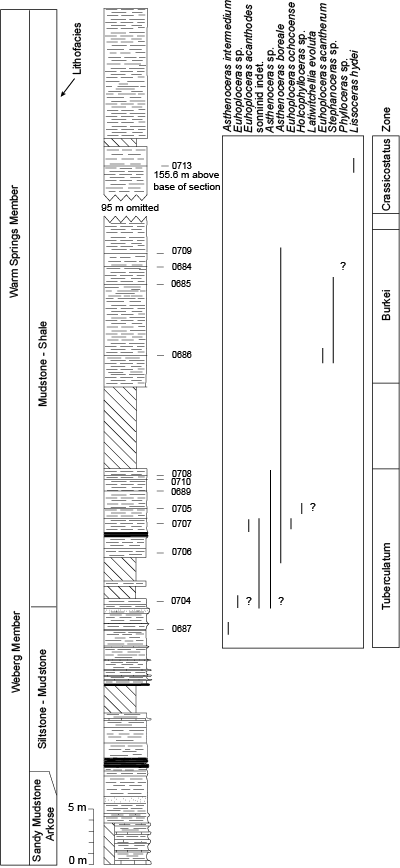
Click on thumbnail to enlarge the image.
Location 17.- The Howard Valley section includes the upper Weberg Member and the Warm Springs Member with the lower beds of the olive-gray mudstone facies.

Click on thumbnail to enlarge the image.
Location 18.- The Weberg Member at the Bedortha Ranch section unconformably overlies the Carnian Brisbois Member, Vester Formation. "f" in range chart refers to float specimens.
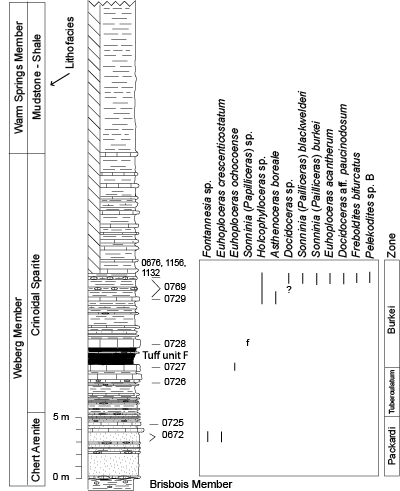
Click on thumbnail to enlarge the image.
Location 19.- The Weberg Member at the Camp Creek section unconformably overlies the Carnian Brisbois Member, Vester Formation. Holotypes of Holcophylloceras supleense and Sonninia (Papilliceras) burkei Taylor (1988) both are from level 1156.
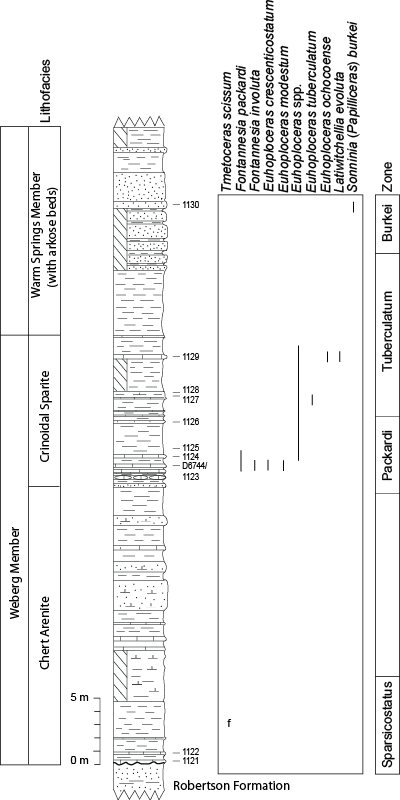
Click on thumbnail to enlarge the image.
Location 20.- The Weberg Member at Packard Draw unconformably overlies the lower Jurassic Robertson Formation. "f" in range chart refers to float specimens.
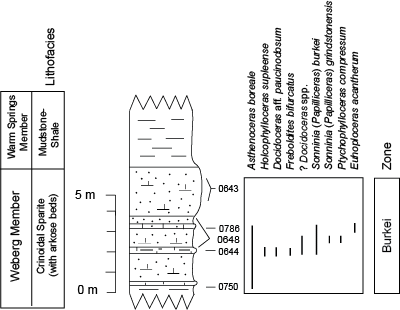
Click on thumbnail to enlarge the image.
Location 21.- The Swamp Creek section includes beds at the top of the Weberg Member and base of the Warm Springs Member.
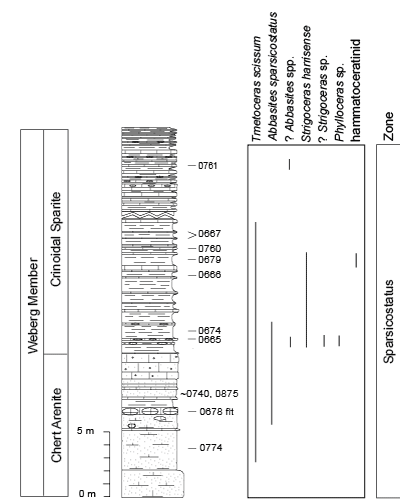
Click on thumbnail to enlarge the image.
Location 22.- The Harris Place section unconformably overlies the lower Jurassic Robertson Formation. Holotype of Strigoceras harrisense (Taylor, 1988) is from this section.